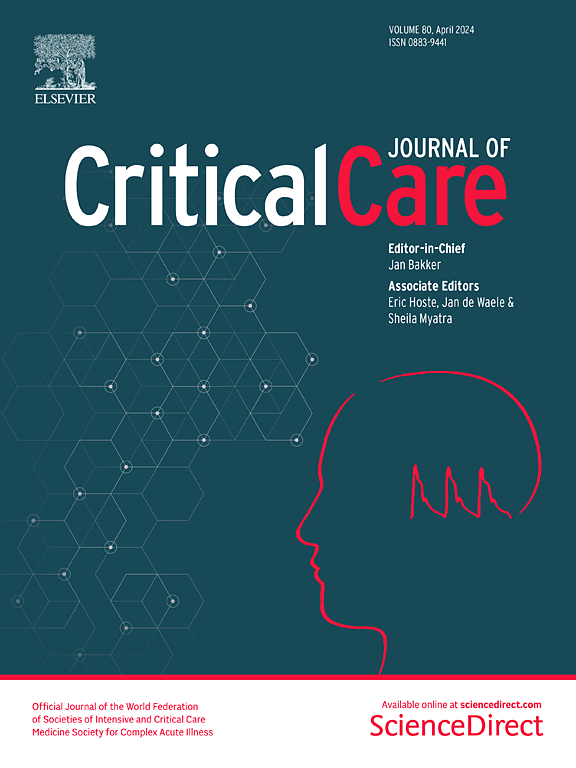糖皮质激素治疗增加危重病期间胆固醇的供应:对肾上腺和肌肉功能的影响
IF 8.8
1区 医学
Q1 CRITICAL CARE MEDICINE
引用次数: 0
摘要
低胆固醇血症是危重症的特征,但其潜在的病理生理学尚不完全清楚。由于循环胆固醇水平低的部分原因可能是皮质醇/皮质酮的转化增加,我们假设糖皮质激素治疗通过减少肾上腺皮质醇/皮质酮的新合成,可能会改善胆固醇的供应,从而影响肾上腺和骨骼肌的功能。在 EPaNIC RCT 所包括的一组匹配的长期重症患者(n = 324)中,我们进行了一项二次分析,以评估糖皮质激素治疗与 ICU 入院至第五天血浆胆固醇之间的关系。接着,在盲肠结扎和穿刺诱发败血症的小鼠模型中,与健康小鼠(n = 18)相比,败血症小鼠随机接受氢化可的松(1.2 毫克/天)(n = 17)或安慰剂(n = 15)治疗 5 天。对血浆皮质酮、胆固醇、肾上腺皮质和肌纤维胆固醇进行了量化。对肾上腺结构和类固醇生成能力进行了评估。对肌肉力量以及萎缩、纤维化和再生的标志物进行了量化。在一项设计相同(n = 24)的连续小鼠研究中,通过回波核磁共振成像(EchoMRI)评估了全身组成,以研究对瘦体重、脂肪、总水和游离水的影响。在人类患者中,糖皮质激素治疗与较高的血浆高密度脂蛋白胆固醇和低密度脂蛋白胆固醇有关,分别从重症监护室第二天和第三天开始,直至第五天(P < 0.05)。与安慰剂相比,氢化可的松治疗的脓毒症小鼠血浆皮质酮不再升高,而脓毒症引起的血浆高密度脂蛋白胆固醇和低密度脂蛋白胆固醇以及肾上腺皮质胆固醇的降低有所减弱(P < 0.05),但肾上腺皮质促肾上腺皮质激素诱导的 CORT 反应没有改善,肾上腺皮质炎症和凋亡增加(P < 0.05)。与安慰剂相比,氢化可的松治疗的败血症小鼠的总体重进一步下降(P < 0.01),但对肌肉质量、力量或肌纤维大小没有额外影响。脓毒症引起的肌肉萎缩和纤维化指标的上升不受氢化可的松治疗的影响,而与安慰剂相比,肌肉再生指标受到抑制(P < 0.05)。与安慰剂相比,氢化可的松治疗的败血症小鼠瘦体重、总水和游离水的损失增加(P < 0.05)。糖皮质激素治疗部分缓解了危重病诱发的低胆固醇血症,但代价是肾上腺功能受损、肌肉再生受抑制以及体质量损失加剧。本文章由计算机程序翻译,如有差异,请以英文原文为准。
Glucocorticoid treatment increases cholesterol availability during critical illness: effect on adrenal and muscle function
Hypocholesterolemia hallmarks critical illness though the underlying pathophysiology is incompletely understood. As low circulating cholesterol levels could partly be due to an increased conversion to cortisol/corticosterone, we hypothesized that glucocorticoid treatment, via reduced de novo adrenal cortisol/corticosterone synthesis, might improve cholesterol availability and as such affect adrenal gland and skeletal muscle function. In a matched set of prolonged critically ill patients (n = 324) included in the EPaNIC RCT, a secondary analysis was performed to assess the association between glucocorticoid treatment and plasma cholesterol from ICU admission to day five. Next, in a mouse model of cecal ligation and puncture-induced sepsis, septic mice were randomized to receive either hydrocortisone (1.2 mg/day) (n = 17) or placebo (n = 15) for 5 days, as compared with healthy mice (n = 18). Plasma corticosterone, cholesterol, and adrenocortical and myofiber cholesterol were quantified. Adrenal structure and steroidogenic capacity were evaluated. Muscle force and markers of atrophy, fibrosis and regeneration were quantified. In a consecutive mouse study with identical design (n = 24), whole body composition was assessed by EchoMRI to investigate impact on lean mass, fat mass, total and free water. In human patients, glucocorticoid treatment was associated with higher plasma HDL- and LDL-cholesterol from respectively ICU day two and day three, up to day five (P < 0.05). Plasma corticosterone was no longer elevated in hydrocortisone-treated septic mice compared to placebo, whereas the sepsis-induced reduction in plasma HDL- and LDL-cholesterol and in adrenocortical cholesterol was attenuated (P < 0.05), but without improving the adrenocortical ACTH-induced CORT response and with increased adrenocortical inflammation and apoptosis (P < 0.05). Total body mass was further decreased in hydrocortisone-treated septic mice (P < 0.01) compared to placebo, with no additional effect on muscle mass, force or myofiber size. The sepsis-induced rise in markers of muscle atrophy and fibrosis was unaffected by hydrocortisone treatment, whereas markers of muscle regeneration were suppressed compared to placebo (P < 0.05). An increased loss of lean body mass and total and free water was observed in hydrocortisone-treated septic mice compared to placebo (P < 0.05). Glucocorticoid treatment partially attenuated critical illness-induced hypocholesterolemia, but at a cost of impaired adrenal function, suppressed muscle regeneration and exacerbated loss of body mass.
求助全文
通过发布文献求助,成功后即可免费获取论文全文。
去求助
来源期刊

Critical Care
医学-危重病医学
CiteScore
20.60
自引率
3.30%
发文量
348
审稿时长
1.5 months
期刊介绍:
Critical Care is an esteemed international medical journal that undergoes a rigorous peer-review process to maintain its high quality standards. Its primary objective is to enhance the healthcare services offered to critically ill patients. To achieve this, the journal focuses on gathering, exchanging, disseminating, and endorsing evidence-based information that is highly relevant to intensivists. By doing so, Critical Care seeks to provide a thorough and inclusive examination of the intensive care field.
 求助内容:
求助内容: 应助结果提醒方式:
应助结果提醒方式:


